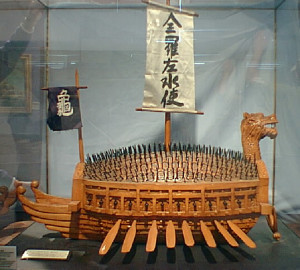Location: North Gallery
The Ship
Throughout its early history, Korea repeatedly had to fend off Japanese invaders and the Turtle Ship earned its place in history by being successful at accomplishing that task.
The first launch of a Turtle Ship was recorded in 1413 and the design was further improved upon by Admiral Yi, Sun-shin in 1592. Some sources quote the vessel as being about 60 feet long and 25 feet wide. Others say the craft was 120 feet long. If the beam is anywhere near correct, the 60-foot length seems more likely. The hull was covered by a double layer of iron and the top surface was covered with iron spikes like a porcupine, to injure those who tried to jump aboard. Narrow cross-shaped pathways allowed sailors to walk on the roof. No mentioned is made in the literature as to how the crew boarded the ship. The museum’s model, however, has what appear to be door frames around four of the roof shields, two on each side. These shields may have been removable to make entry ways.
The model shows eleven cannon each side and two at each end for a total of 26. At the bow is a large figurehead and, at the stern, a tail. One source claims that a cannon was fired from the dragon’s mouth; another says that sulphur was burned to create a smoke screen.
The ship was propelled by eight oars on each side and it is said to have required a crew of 90 to man the oars and cannon. A tall, square-headed lug sail with numerous battens (patterned after the Northern Chinese) is pictured in some sources, but the vessel was clearly intended to be used for inshore battles, not for extensive off-shore sailing.
Admiral Yi’s Turtle Ship proved to be the solution to overpowering a much larger Japanese Navy, thus becoming the first ironclad in history. The Admiral’s successes are commemorated in Hanlyosudo National Park in South Korea by a navigation beacon with a base representing a turtle ship and a monument celebrating his victory, also with a stylized turtle ship base.
A full size replica of a turtle ship is located at the Korean Naval Academy in South Korea
The Model
Solid construction by an unknown builder
Case: H 43” L 46” W 36”
Source: University of Hongik, Korea

